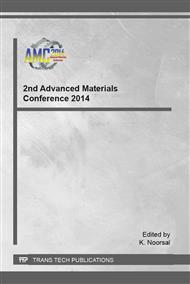[1]
K-C. Tsay, L. Zhang, J. Zhang, Effect of electrode layer composition/thickness and electrolyte concentration on both specific capacitance and energy density of supercapacitor, Electrochim. Acta 60 (2012) 428-436.
DOI: 10.1016/j.electacta.2011.11.087
Google Scholar
[2]
S. Shivakumara, T.R. Penki, N. Munichandraiah, Synthesis and characterization of porous flowerlike α–Fe2O3 nanostructures for supercapacitor application, ECS Electrochemistry Letters 2 (7) (2013) A60-A62. 2.
DOI: 10.1149/2.002307eel
Google Scholar
[3]
A.S. Adekunle, K.I. Ozoemena, B.B. Mamba, B.O. Agboola, O.S. Oluwatobi, Supercapacitive properties of symmetry and the asymmetry two electrode coin type supercapacitor cells made from MWCNTS/Nickel oxide nanocomposite, Int. J. Electrochem. Sci. 6 (2011).
DOI: 10.1016/s1452-3981(23)18364-7
Google Scholar
[4]
R. Farma, M. Deraman, Awitdrus, I. A Talib, R. Omar, J.G. Manjunatha, M.M. Ishak, N.H. Basri, B.N.M. Dolah, Physical and electrochemical properties of supercapacitor electrodes derived from carbon nanotube and biomass carbon, Int. J. Electrochem. Sci. 8 (2013).
DOI: 10.1016/s1452-3981(23)14018-1
Google Scholar
[5]
V. Subramaniam, H. Zhu, R. Vajtai, P.M. Ajavan, B. Wei, Hydrothemal synthesis and pseudocapacitance properties of MnO2 nanostructures, J. Phys. Chem. B. 109 (2005) 20207-20214.
DOI: 10.1021/jp0543330
Google Scholar
[6]
B. Mazinani, A. Beitollahi, A.K. Masrom, S. Ibrahim, F. Jamil, The effect of hydrothermal temperature on structural and photocatalytic properties of ordered large pore size TiO2-SiO2 mesostructured composite, AIP Conf Proc. 1502 (2012) 272.
DOI: 10.1016/j.jallcom.2011.12.051
Google Scholar
[7]
F. Lufrano, P. Staiti, Mesoporous carbon materials as electrodes for electrochemical supercapacitors, Int. J. Electrochem. Sci. 5 (2010) 903-916.
DOI: 10.1016/s1452-3981(23)15331-4
Google Scholar
[8]
J. Wang, Q, Liu, Structural change and characterization in nitrogen-incorporated SBA-15 oxynitride mesoporous materials via different thermal history, Microporous and Mesoporous Materials. 83 (2005) 225-232.
DOI: 10.1016/j.micromeso.2005.04.012
Google Scholar
[9]
T. Sato, S. Marukane, T. Morinaga. Ionic liquids for the electric double layer capacitor applications, application of ionic liquids in science and technology. Edited by Prof Scott Handry. ISBN: 9978-953-307-605-8, InTech Europe Publisher (2011).
DOI: 10.5772/23412
Google Scholar


